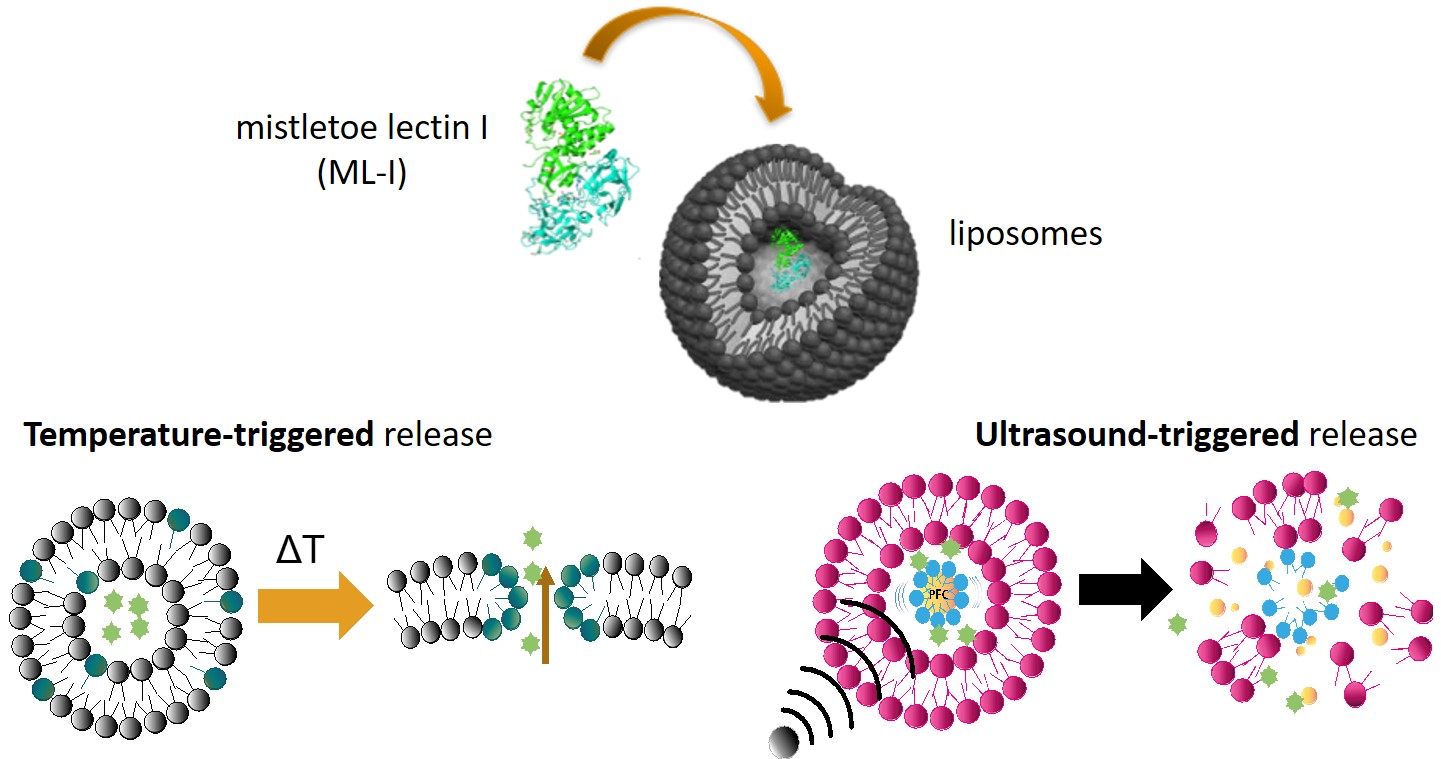Encapsulation of plant-derived toxins in stimuli-sensitive liposomes
Prof. Dr. R. J. Kok1), University Utrecht/The Netherlands
People involved
Maria B.C. de Matos (PhD fellow sponsored by the PRC) – University Utrecht, The Netherlands
Abstract
This project concerns the development of stimuli-responsive liposomes for the controlled release of therapeutic proteins, such as mistletoe lectin-I (ML-I). ML-I is a potent plant-derived toxin that can be used in cancer therapy, like other lectins such as ricin and cholera toxin. Encapsulation of such bioactive proteins in nanocarriers serves two purposes: protection of the body towards the bioactivity of the toxin – by limiting its distribution and interaction with target cells – and protection of the bioactive protein against degrading enzymes and systemic clearance. One of the major challenges in this project is the release of the macromolecular cargo from the liposomal nanocarriers, which requires destabilization or disruption of the lipid bilayer. We will employ two different types of stimuli-sensitive nanocarriers, either temperature-sensitive liposomes (TSL)1)2) or ultrasound-sensitive liposomes (USL)3), which can release the therapeutic cargo based on different underlying mechanisms of bilayer destabilization.

Overall aim of this project: Toxin-loaded nanomedicines for cancer treatment. The entrapment of mistletoe lectin I (ML-I) in liposomes protects the bioactive protein against degradation, while also preventing off-target effects caused by the toxin. Since ML-I cannot pass over the lipid membrane, we will employ stimuli-sensitive liposomes that can be destabilized by external stimuli such as heat (phase transition of lysolipid-containing lipid bilayer) and ultrasound (cavitation triggered disruption of lipid bilayer).
The proposed nanomedicine strategy for tumor-directed delivery of ML-I is a two-step approach, that is the combination of nanoparticle-driven accumulation of long-circulating liposomes in the tumor interstitium and a secondary focused heat or ultrasound pulse that triggers ML-I release locally. Such a two-step strategy will direct the cell-killing effect of the toxin primarily towards tumor cells and, consequentially, ML-I loaded liposomes will be much better tolerated than the parenteral (intravenous) administration of free toxin. We will demonstrate the feasibility of ML-I loaded stimuli-sensitive liposomes in an in vitro setup with tumor cells. The present application is dedicated to the characterization of different compositions of ML-I loaded TSL and USL, their evaluation for stability and triggered release, and the in vitro cellular handling and efficacy of the most promising formulations by live cell-imaging.
Benefit for the community
Nanomedicines have great potential for improving the tumor-directed distribution of anticancer drugs. This project explores whether such approaches can be used for plant-based toxins. Eventually, when safety and efficacy of such toxin-loaded liposomes can be demonstrated, such nanomedicines can be used in the treatment of cancer.
Results/Outcome
The scientific results demonstrate that ML-I can be formulated in TSL and USL and that bioactivity of the loaded cargo can be studied in an in vitro setting confirming the protective effect of the nanocarrier, the predicted behavior of the nanocarrier resulting in the proper cellular interaction (uptake and cell death) of the formulated ML-I. Our results underscore the potential of the stimuli-sensitive triggerable liposomes for tumor-directed delivery of cytotoxins. Nevertheless, the ML-I loading content of the final ML-I-USL10 was sufficient for follow-up experiments in which this type of nanocarrier showed at least comparable performance (storage stability studies) or even better outcome as compared to ML-I-TSL (fraction triggered release over 90% for ML-I-USL10 versus 10% release for ML-I-TSL). Since the formulation in USL showed a triggered release of over 90% compared to 10% release from TSL, USL are therefore a promising approach, despite the complex purification procedure and the initial losses of the encapsulated cargo. We therefore conclude that the overall aim of the project, i.e. formulation of potent cytotoxins in lipid-based nanocarriers, has been successfully achieved.
Visit the supervisors lab
Overcoming limitations in nanoparticle drug delivery: triggered, intravascular release to improve drug penetration into tumors
Cancer Res. 72, 5566-5575
| PubMed |
Thermosensitive liposomal drug delivery systems: state of the art review
Int. J. Nanomedicine 9, 4387-4398
| PubMed |
Thermosensitive liposomes for triggered release of cytotoxic proteins
Eur. J. Pharm. Biopharm. 132, 211-221
| PubMed |
Ultrasound-Sensitive Liposomes for Triggered Macromolecular Drug Delivery: Formulation and In Vitro Characterization
Front Pharmacol. 10, 1463
| PubMed |


